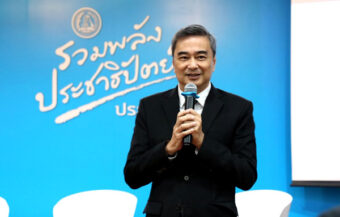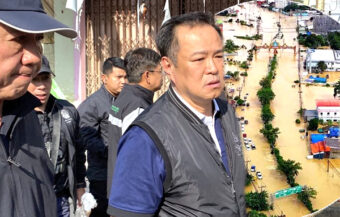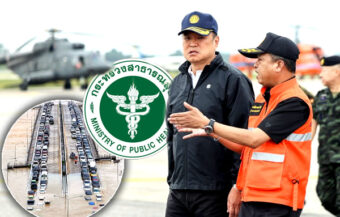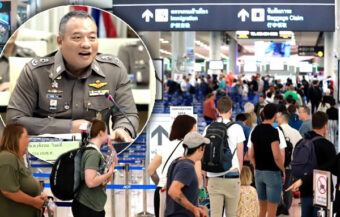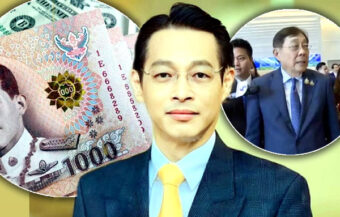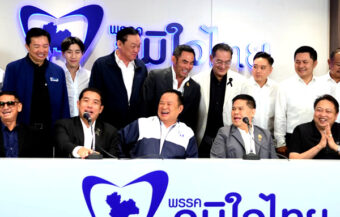Thai Senate chair urges government to accept Trump’s 36% tariff now, then cut tariffs slowly to protect SMEs amid tense US trade talks. Balancing risks, Thailand fights to keep exports strong while avoiding the collapse of key industries and national instability.
The Chairman of the Senate Committee on Commerce is demanding the government accept Trump’s 36% tariff—and later gradually lower tariffs on US imports. This comes as Thailand scrambles to nail down a trade deal with the US. Right now, Thailand aims for an 18% tariff, as the Deputy Prime Minister and Finance Minister reportedly offered a 0% tariff on 90% of American goods just last Wednesday. That’s even lower than Vietnam’s 20% and Indonesia’s 19% deals. Yet government officials warn that winning isn’t just about slashing rates. However, lower tariffs may crush weaker Thai factories and producers. But the real battleground is the headline tariff on exports to the US—it will make or break future investment into Thailand.
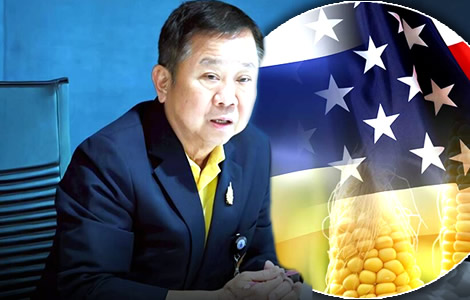
On Thursday, the Chairman of the Senate Committee on Commerce urged the Thai government to accept the U.S. tariff threat. President Donald Trump proposed a 36% tariff on many U.S. imports. Instead of opening markets broadly, the Committee advised Thailand to accept this tariff.
This recommendation came amid growing concerns over the impact of trade liberalization on small and medium-sized enterprises (SMEs). Furthermore, the Committee worries that too much openness could threaten national stability.
Thailand’s conservative Senate is currently under pressure due to an election collusion probe. In turn, this has drawn attention to the Senate majority’s stridently conservative voice in national debates.
Senate urges acceptance of 36% U.S. tariff amid fears of trade liberalization impact on SMEs and stability
They oppose wide-ranging trade liberalization similar to that in Vietnam and Indonesia. Both countries recently agreed to deep tariff cuts in exchange for U.S. concessions. However, the Thai Senate majority believes such moves could harm domestic industries.
In recent days, rumors about a U.S. naval base in Phang-nga province have circulated widely. Although officials officially deny these rumours, they continue to spark heated debate, driven by Conservative elements. Nevertheless, government representatives continue to insist no naval base plans are linked to the trade talks. Meanwhile, the U.S.-Thailand trade negotiations have reached a critical stage.
Deputy Prime Minister and Finance Minister Pichai Chunhavajira met with U.S. Trade Representative Jamieson L. Greer on Wednesday night online. During the meeting, Thailand proposed eliminating tariffs on 90% of U.S. imports. This offer marks a significant increase from an earlier proposal covering only 60%. The goal was to avoid the steep 36% U.S. tariff. Still, insiders doubt this will fully satisfy U.S. demands.
Thailand now aims for a tariff rate of 18%. This target is slightly lower than Vietnam’s 20% and Indonesia’s 19%. Officials want to protect Thai industries while maintaining competitive export access. Moreover, concerns about Chinese transshipments influence U.S. tariff policies heavily. For instance, many Vietnamese goods face 40% tariffs due to suspected transshipments. Thailand argues it differs because its manufacturing has higher local content.
Thai Senate resists deep tariff cuts, fearing damage to industries, while trade talks with U.S. grow intense
The Senate Committee on Commerce warns against excessive market liberalisation. They stress the risk of many SMEs collapsing under such pressure. In turn, this collapse could destabilize the broader economy. More alarmingly, the Committee links economic harm to potential military security risks. Instead, they urge the government to explore new export markets. These markets include the European Union and various African countries.
On July 17, Committee Chairman Wiwat Kraipisitkul explicitly cautioned against replicating Vietnam’s free-market approach. Vietnam and Indonesia reduced tariffs to zero on all U.S. goods. In exchange, the U.S. lowered its tariffs to around 19-20%. Mr. Wiwat warns this model would devastate Thailand’s SMEs, especially in agriculture and livestock. These sectors are crucial for Thailand’s supply chains.
Mr. Wiwat also highlighted the fragile state of Thai SMEs. Many have struggled due to prolonged economic challenges. Opening markets too widely might push many to bankruptcy. He further warned that economic damage could affect national security. Thailand’s exports to the U.S. total about ฿1.9 trillion. This figure equals 18% of total exports, less than Vietnam’s 30%. Mr. Wiwat argues Thailand faces unique disadvantages in negotiations. Thus, it should avoid imitating Vietnam’s strategy.
Senate committee warns against market liberalization and urges diversification of Thailand’s export markets
Instead, he proposed accepting the 36% U.S. tariff initially. Then, the government could partially cut tariffs by about 10%. This approach would receive support from subsidies, private investors, and bank loans. Mr. Wiwat believes this strategy is safer than wholesale liberalization. It could prevent widespread damage to SMEs and the economy.
He also identified some U.S. products suitable for tariff exemptions. For example, chemical fertilisers could be exempted without problems. Fertilisers help Thai farmers reduce production costs. They also address environmental problems, such as PM 2.5 pollution from corn farming. Thus, tariff relief on fertilizers benefits multiple sectors.
A business group advising the government confirmed Thailand’s new offer. It eliminates tariffs on roughly 90% of U.S. goods.
Proposal to accept 36% tariff with partial cuts aims to protect SMEs and boost sectors like agriculture
Thai Chamber of Commerce vice-chairman Chanintr Chalisarapong explained the proposal’s impact. It could reduce Thailand’s $45.6 billion trade surplus with the U.S. by 70% in three years. Moreover, balanced trade might be achieved within five years.
Mr. Chanintr claimed the offer is more ambitious than previous ones. It surpasses the July 6 proposal, which covered 60% of products. He is confident the proposal is practical and should satisfy U.S. demands. Thailand, as a manufacturing hub, imports many U.S. goods for production. This gives Thailand leverage in supply chain negotiations.
Meanwhile, the U.S. has already set tariffs at 20% for Vietnam and 19% for Indonesia. However, many Vietnamese goods face 40% tariffs due to transshipments. If Thailand fails to reach a deal, exports to the U.S. could fall sharply. Last year, exports to the U.S. represented 18% of Thailand’s total shipments.
Political uncertainty surrounds the trade talks due to Prime Minister Paetongtarn Shinawatra’s suspension. This suspension came from a court order over ethical misconduct allegations. The government faces pressure to finalize a deal quickly to stabilize the economy.
Thai chamber says tariff offer could slash us trade surplus by 70% and aims to stabilise economy amid political crisis
Thailand’s exports grew about 15% in the first five months of 2025. Much of this growth is due to frontloading before potential tariffs. However, high household debt and weak domestic demand remain risks. A favorable trade agreement could ease investor worries.
The government also plans broad economic stimulus measures. Deputy Finance Minister Paophum Rojanasakul said a ฿200 billion soft loan program is underway. This program targets businesses hurt by tariffs. Additional debt relief and interest rate reductions are planned soon.
New loans will help exporters seek alternative markets in the EU and Africa. Tax incentives will encourage entrepreneurs to diversify beyond the U.S. market. Mr. Paophum stressed that the best deal balances benefits and costs. Opening the market too widely could harm strategic sectors.
He explained Vietnam’s trade deal features two tariff rates. Products with high regional content face 20% tariffs. Goods with low local input pay 40%, due to Chinese transshipments. Many Vietnamese exports may be taxed at the higher rate.
In contrast, Thailand’s manufacturing sector has higher local and regional content. This difference should give Thailand a negotiating advantage. Thailand is also discussing tariff exemptions on U.S. digital services in Thailand. Moreover, talks include importing U.S. liquefied natural gas and Boeing aircraft.
Economic stimulus and new trade deals aim to offset risks while Thailand leverages higher local content
Additionally, key agricultural products like corn and soybeans are part of the negotiations. These imports would lower costs for Thai animal feed producers. This benefit extends to poultry, livestock and food processing industries. Ultimately, this could boost productivity and competitiveness.
Minister Pichai Chunhavajira seeks the best possible tariff rate. He expects more talks soon with U.S. Trade Representative Greer. Both parties agreed to reduce import taxes on scarce U.S. products. They also plan stricter rules to prevent transshipments.
Trump tariff crisis has exposed the colonisation of the Thai economy by Chinese zero-dollar factories
Thai SME sector raises the alarm as the government struggles to deal with a fast-moving US tariff crisis
Thaksin joins Thai tariff crisis talks at Phitsanulok Mansion. Confirms real fears of Chinese retaliation
Thai negotiators hope to complete the deal before August 1. Otherwise, the 36% tariff threat will take effect. Delays have already hurt trade confidence.
The government also aims to strengthen Thailand’s status as a regional financial hub. Plans include infrastructure improvements, debt relief and crypto investment schemes from tourists.
Overall, the negotiations reflect a delicate balance. The government must protect SMEs and strategic industries. At the same time, it must maintain export competitiveness in the U.S. market, its biggest. The final deal will shape Thailand’s economy for years to come.



